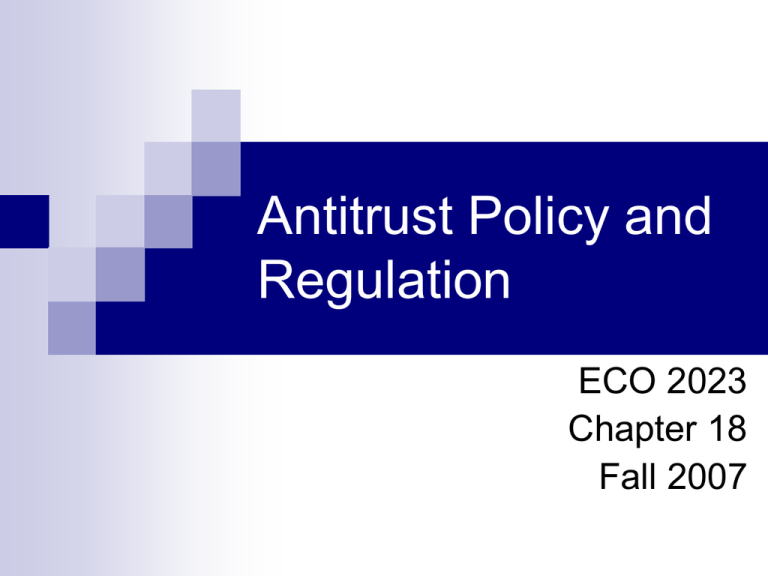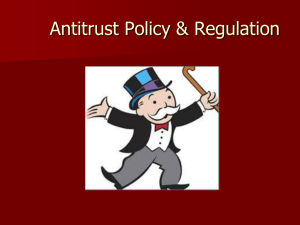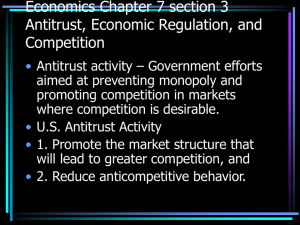Antitrust Policy and Regulation
advertisement

Antitrust Policy and Regulation ECO 2023 Chapter 18 Fall 2007 Market Power The ability of a firm to raise its price without losing all its customers to rival firms Any firms facing a downward sloping demand curve has some control over the price and thus some market power Government Policies Social regulation Government regs aimed at improving health and safety Economic regulation Government regulation of natural monopoly where because of economies of scale, average production cost is lowest when a single firm supplies the market. Antitrust The purpose of antitrust policy is to prevent monopolization, promote competition, and achieve allocative efficiency. Pursed in courts History After Civil War National markets were created Dominant firms formed in several industries Oil, meatpacking, railroads, sugar, lead, coal and tobacco Oligopolists became TRUSTS Business combinations that assign control to a single decision group Questionable tactics used Government Involvement Two alternative means of control Regulatory For natural monopolies Antitrust agencies laws Social control took the form of antitrust legislation designed to inhibit or prevent the growth of monopoly Origins of Antitrust Policy Economics developments in the 19th century created bigger firms serving wider markets Two most important developments Technological breakthroughs that led to a larger optimal plant size in manufacturing The rise of the railroad which reduced transport costs Economies of scale and cheaper transport costs extended the geographical size of markets, so firms grew larger and served a wider geographical market Sherman Act of 1890 Section 1 Every contract, combination in the form of a trust or otherwise, or conspiracy in RESTRAINT OF TRADE or commerce among the several states, or with foreign nations is hereby declared to be illegal Sherman Act of 1890 Section 2: every person who shall monopolize, or attempt to monopolize, or combine or conspire with any person or persons, to monopolize any part of the trade or commerce among the several states or with foreign nations, shall be deemed guilty of a felony Sherman Act of 1890 Restraint of trade Collusive price fixing Dividing up markets Prohibited trusts Injured private parties or state attorney generals can file antitrust suits against alleged violators of the act Treble damages Clayton Act of 1914 Contained the desired elaboration of the Sherman Act. Section 2: outlaws price discrimination when such discrimination is not justified on the basis of cost differences and when it reduces competition Section 3: prohibits tying contracts a producer requires that a buyer purchases another of its products as a condition for obtaining a desired product. Also exclusive dealings Clayton Act of 1914 Section 7: prohibits the acquisition of stocks of competing corporations when the outcome would be less competition Section 8 prohibits the formation of interlocking directorates – situations where a director of one firm is also a board member of a competing firm in large corporations where the effect would be reduced competition Federal Trade Commission Act of 1914 FTC Act Created the five member FTC which has joint Federal responsibility with the Justice Dept for enforcing the antitrust laws. Power to investigate unfair competitive practices on its own initiative or at the request of injured firms Public hearings, cease and desist orders Wheeler-Lea Act of 1938 Gave FTC the additional responsibility of policing deceptive acts or practices in commerce False or misleading advertising Misrepresentation of products Established FTC as an independent antitrust agency Made unfair and deceptive sales practices illegal Celler-Kefauver Act of 1950 Amended the Clayton Act which prohibits a firm from merging with a competing firm by acquiring its stock to prohibit the purchase of physical assets Prevents Horizontal mergers Vertical mergers Antitrust Policy The effectiveness of any law depends on how the courts interpret it and on the vigor of the government enforcement. Courts have been inconsistent in interpreting the antitrust laws Issues of Interpretation Monopoly power vs. Monopoly structure Court Cases Standard Oil (1911) Guilty of monopolizing the petroleum industry through a series of abusive and anticompetitive actions Court divided Standard Oil into competing firms Issues of Interpretation Court cases US Steel case (1920) Courts established a rule of reason Alcoa That not every monopoly is illegal Only monopolies that unreasonably restrain trade violate Sherman Act case (1945) 20 year turnabout Even though the firm’s behavior might be legal, the mere possession of monopoly power violated the antitrust laws. Issues of Interpretation Structuralists Say that a firm with a very high market share will behave like a monopolist. Behavioralists Assert that the relationship between structure, behavior, and performance is tenuous and unclear. Effectiveness of Antitrust Laws On the basis of the rule of reason, the government has generally been lenient in applying antitrust laws to monopolies that have developed naturally Firms sued by government if evidence of abusive conduct Mergers Three basic types of mergers Horizontal Merger Is a merger between two competitors that sell similar products in the same geographic market Vertical Merger A merger between firms at different stages of the production process Conglomerate merger Any merger that is not horizontal or vertical Different industries Horizontal Merger Is a merger between two competitors that sell similar products in the same geographic market Vertical Merger A merger between firms at different stages of the production process Conglomerate merger Any merger that is not horizontal or vertical Different industries







